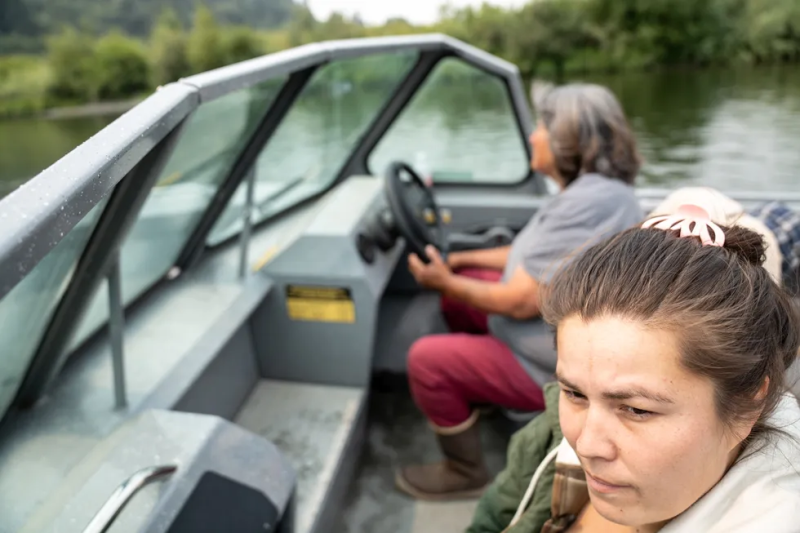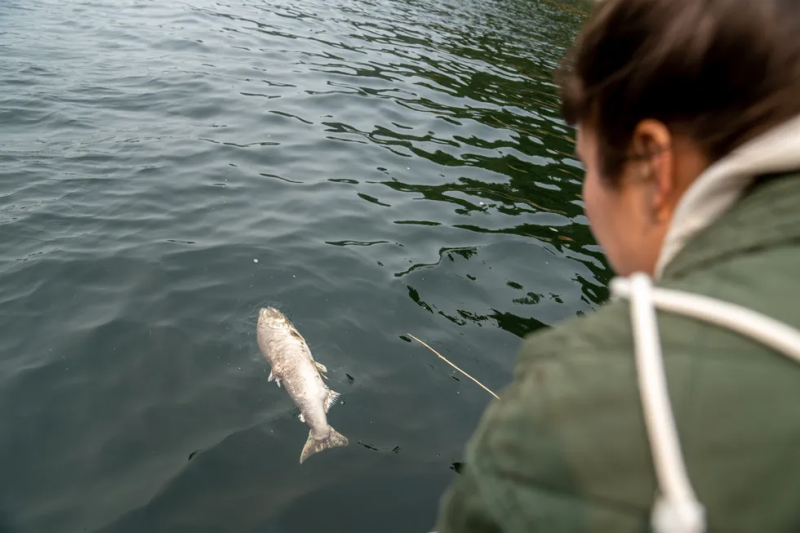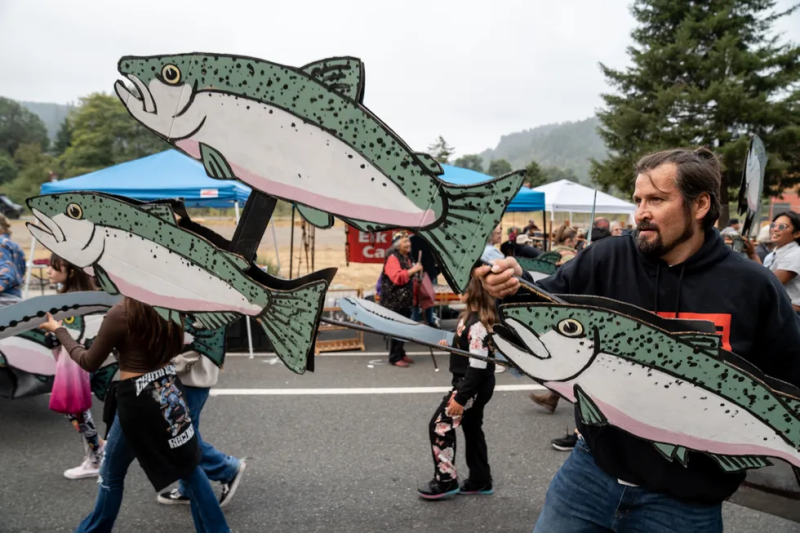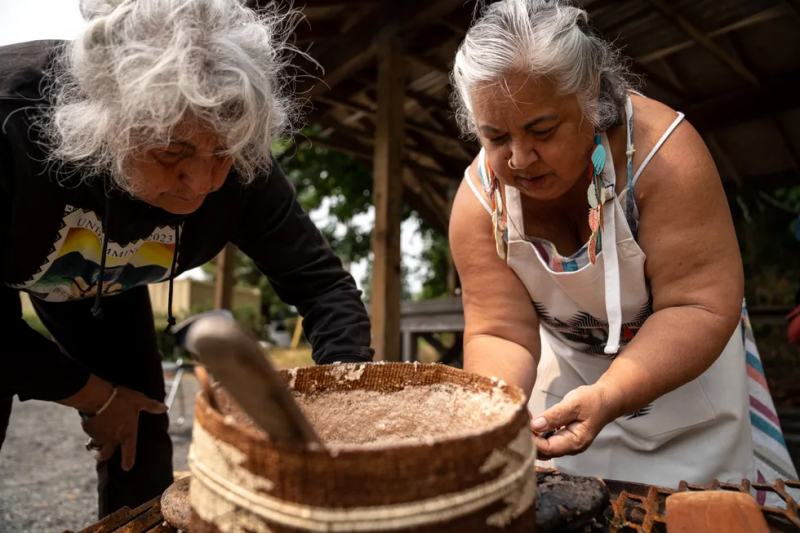Salmon won't return to the Klamath River overnight, but tribes are ready for restoration work
REQUA, Calif. — The last of four hydroelectric dams on the Klamath River is expected to come down in 2024, restoring the river's full flow and the spawning grounds for fish for the first time in more than 100 years.
But for the people who live there — and some who have lived on the river for up to 15,000 years — the removal of the dams is just the beginning of the Klamath's recovery.
Fish protectors like Oscar and Georgianna Gensaw of the Yurok Tribe expect the salmon's return to take years. Also ahead are the arduous tasks of restoring forests ravaged by huge wildfires, repairing the damage to creeks and rivers that were dredged and channelized to dry up wetlands that once made their waters clear and pure, and mitigating other damage to lands and waters occurring over the past 150 years.
But tribes say the effort is vital to the survival of their peoples, lands and waters.
“We need a healthy ecology to be a healthy people,” former Klamath Tribes Chairman Don Gentry said.
Tribes and environmentalists fought for decades to remove the dams that blocked the Klamath River’s natural flow and held back water in shallow reservoirs that at times were breeding grounds for pathogenic algae that contributed to toxic water conditions downriver. The fetid waters flowing out of the reservoirs caused the West’s largest fish kill in 2002.
The dams, considered obsolete, were finally decommissioned and, after at least one false start, the federal government signed off on the removal project, the largest in U.S. history, in November 2022.
The massive project involves construction companies, ecological restoration firms and tribes, and will reopen nearly 400 miles of fish spawning and nursery habitat. The first dam was removed this summer.
Although most of the Klamath will soon flow freely again, the salmon runs won’t come back in a year or even a decade. Some Native people don’t expect to see full river or fish recovery in their lifetimes.
Klamath River Basin tribes watch, wait and prepare
The Yurok, the Karuk, the Shasta and the Klamath tribes are waiting to see what happens after the dams come down even as they restore their ancestral and trust lands, waterways and fish habitats. But the four tribes, which hold land through which the mainstem of the Klamath flows, are not the only tribes involved in restoring the health of California's second-biggest river system.
The Hoopa Valley Tribe and the Quartz Valley Indian Community of the Quartz Valley Reservation have both trust lands and ancestral lands in and around the Klamath's most important tributaries.
The Hoopa Valley Tribe's 12-square-mile reservation is the largest trust land tract in California. The Trinity River, the Klamath's largest tributary, meets the Klamath at Weitchpec. But the Trinity has had much of its flow diverted to the Central Valley. The conveyance system to ferry water down to southern California means that a molecule of Trinity River water could possibly end up on landscaping at Disneyland, said Hoopa Fisheries Department director Mike Orcutt.
At one time, as much as 90% of the Trinity's natural flow was diverted to irrigate farms, fill swimming pools and sustain landscaping in the Central Valley and southern California.
That, along with drought, climate change and increasing water temperatures, has also led to a significant decline in salmon. The construction of dams have cut off about 50% of salmon and steelhead spawning habitat, Orcutt said.
The tribe is trying now to make the government abide by its own laws.
Reservations are entitled to sufficient water to fulfill the goals of that reservation according to a U.S. Supreme Court decision known as the Winters doctrine. Subsequent laws and court decisions have upped the river’s water to just shy of 50% of the Trinity’s flow before dam construction. But the tribe is always watching efforts by agricultural users like the Westlands Water District to obtain more water, even though Congress allocated only surplus flows in the Trinity to other uses.
Since the health of the Hoopa Tribe and its valley depends on the health of the Trinity, the tribe, which gave up most of its lands, is determined to make the government hold up its end of the bargain.
The Quartz Valley Reservation's ancestral lands encompass the Scott and Salmon rivers, two important salmon spawning and rearing waterways. Like their big sister, these two rivers have also suffered from drought, gold mining, agricultural runoff and diversion dams that block some spawning areas.
Advocacy organization California Trout said before European contact, more than 80,000 Chinook salmon would swim up the Shasta River each year. At one time, the Shasta, fed by springs from Mount Shasta, was the second most productive tributary for salmon runs. Now, only about 10% of the older runs of Chinook return to the streams, and the Coho salmon are on the razor's edge of local extinction.
The Scott River is also an important salmon nursery, and the Klamath, Karuk and Shasta peoples who make up the membership of the Quartz Valley Indian Reservation have depended on fish for subsistence for as long as they've lived there.
But when the fish numbers plummet past the levels of sustainability, people turn to less healthy foods. That has resulted in four times the national rate of diabetes in the community.
Karuk people used to consume 450 pounds of salmon per person annually, said Quartz Valley Environmental Director Sarah Schaefer, a number that’s plunged to less than 5 pounds per person after the dams' construction. The mental health of the Native peoples of the Klamath Basin also suffers, with high rates of suicide. Restoring the health of the Klamath and its fish will restore the health of the people, Schaefer said.
"If the Coho dies in the Scott River you can't replace them," said Karuk Councilman Aaron “Troy” Hockaday. "Until we get all the water back the fish won't survive."
Some experts suggested that if the Klamath River Coho go extinct, they could be replaced with salmon from other parts of the West. But Coho from other parts of the West would not be appropriate, according to Hockaday and other tribal representatives, who along with Schaefer spoke at an emergency drought contingency meeting at the California Water Boards in October.
"Salmon populations differ," Hockaday said.
There's been some good news in the Scott River Valley. In June, the Yurok tribe, local utility Farmer's Ditch Company and California Trout signed an agreement to restore salmon habitat and improve agricultural water use on the Scott.
Tribes, others excited about what happens after the dams are demolished
One issue that still needs to be addressed after the last dam is gone, said Yurok Tribal General Counsel Amy Cordalis, is restoring water flows that currently barely sustain the fishes' survival.
"The Endangered Species Act's flows are like putting a person on life support," she said. "They're the bare minimum of what is required to keep fish from going extinct."
The Yuroks have sued the Bureau of Reclamation almost every year since 2017 for failing to meet water flow requirements. "They've given too much water to other buckets, and as a result, there hasn't been enough water in the river to prevent baby Coho from dying," Cordalis said.

Cordalis said she sees dam removal as the end of the era of "farmers versus Indians." The giant project is just the first step in reconnecting the basin and improving water quality and fish species, she said.
Jonathan Czuba, a professor of biological systems engineering at Virginia Tech, agreed with that assessment.
"We didn't get where we're at because of just one action," he said. "There have been more than 100 years of changes in the landscape."
Czuba, who assisted in the restoration of the Elwha River after a dam was removed there, said completing one project would not by itself solve the many changes wrought by dams, ditches and diversions.
And removing the dams won’t immediately bring back salmon runs, Orcutt said. Two other dams on the upper Klamath, the Keno and the Link River dams, are still in place, although unlike the four that are coming down, those dams have fish ladders. Lake Ewauna, about a 15-mile drive upriver from the Keno Dam, also has water quality issues that Orcutt believes will have to be addressed so fish can safely travel through that waterway and the Upper Klamath Lake to their old spawning sites.
Wetland restoration can address many of the water quality issues plaguing c’waam, koptu and other fish. Czuba said water traveling through the dense grasses slows down the flow, enabling sediment and the naturally occurring phosphorus in the region to filter out.
Gentry said the Sprague River, a major tributary of the Upper Klamath Lake, was formerly one such giant wetland system. “It was like a giant sponge,” he said.
When unfiltered water containing high levels of phosphorus flows into Upper Klamath Lake and other lakes in the area, the water becomes saturated with phosphorus, creating a rich nursery for toxic levels of blue-green algae and other noxious growths. That pathogen-loaded water travels downriver, creating toxic water conditions for fish, people and other species. That’s why he and other tribal leaders believe basin-wide restoration would be necessary for basin-wide recovery.

With river's return, ceremony is restored
The tribes along the Klamath River never gave up hope that the touchpoint of their cultures and histories, along with their livelihoods, could be restored. That hope was manifested during the Salmon Festival.
The Yurok Tribe Fishery Department had halted the 2023 fishery after a disastrous spring Chinook run, and wildfires blocked some roads from neighboring tribal communities. Still, about 2,000 people still came to Klamath to celebrate the impending end of the dams and the beginning of restoring salmon runs above them. The theme of the event was “Celebrating Dam Removal and the Healing of the Klamath River.”
The Klamath Tribes brought back their annual "return of c'waam" ceremony three years after their sovereign status was restored in 1986. The ceremony was moved upstream on the Sprague River because of traffic issues on the road paralleling the river, said Klamath Tribal Chairman Clayton Dumont.

The Yurok Tribe continues its millennial-long guardianship of the lower reaches of the Klamath. In 2019, the tribe granted personhood status to the river. This strategy has been used by other Indigenous peoples including the Whanganui iwi, or tribe of Maori people in New Zealand. In 2017, the iwi convinced the New Zealand Parliament to pass legislation to give personhood status to the eponymous Whanganui River in New Zealand to restore and sustain river health.
The Yuroks want to use their sovereignty and their governmental powers to control their own resources and to support other efforts.
"What happens at the top of the river greatly impacts what happens on our reservation," Cordalis said. The recent meeting in Ashland, Oregon, was a step toward empowering tribes and other stakeholders, including the agricultural community, to manage ecosystem-wide restoration efforts.
Community buy-in is essential to making any landscape restoration happen, said Czuba, who cautioned that even though an ecosystem will never be the same as before massive changes like those on the Klamath, projects on a systemwide basis can be effective in finding solutions that benefit both human economies and ecosystems.

"We might have to do things in a slightly different way to be sustainable," he said.
To restore the entire basin, Gentry said, stakeholders need a common understanding of what the real problems are and how inaction contributes to the Klamath’s ongoing crisis.
“We have unintended consequences from decisions made 70 years ago,” he said. Restoring the Sprague River’s wetlands, restricting cattle from waterways and addressing other damaged areas in the river system should be prioritized over building more dams, which would benefit not only ecologies but economies.
Tribes, environmentalists and ranchers are talking over kitchen tables and on front porches to talk about how to restore the upper Sprague River and other tributaries of the Upper Klamath Lake and still make a living, while other downriver efforts like removing dams, restoring salmon spawning and juvenile habitat, restoring fire to the land may eventually put the Klamath Basin to rights.
Even before all the dams are removed and the wetlands restored, the Klamath Tribes' fish-rearing project has begun to show results: In October, the tribe’s fisheries agency, the Amdodat Department, began releasing stocks of c'waam and koptu into the lower Sprague River.
But in addition to restoring the fish and the habitats that sustain them, the Gensaws have another goal in mind: the ability to let their kids and dogs play in the river when summer temperatures reach 100 degrees or higher.
Debra Krol reports on Indigenous communities at the confluence of climate, culture and commerce in Arizona and the Intermountain West. Reach Krol at debra.krol@azcentral.com. Follow her on X, formerly Twitter@debkrol.
Coverage of Indigenous issues at the intersection of climate, culture and commerce is supported by the Catena Foundation.
Disclaimer: The copyright of this article belongs to the original author. Reposting this article is solely for the purpose of information dissemination and does not constitute any investment advice. If there is any infringement, please contact us immediately. We will make corrections or deletions as necessary. Thank you.





